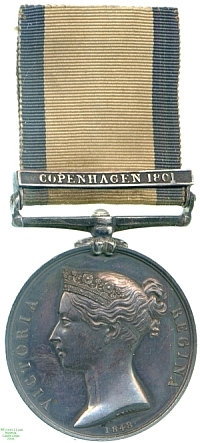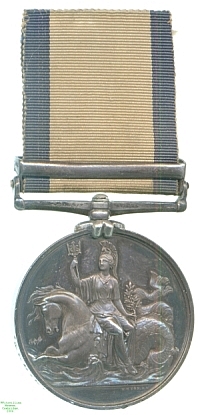
Obverse, a bust of Queen Victoria

Reverse, Britannia with a trident seated sideways on a seahorse

Obverse, a bust of Queen Victoria |

Reverse, Britannia with a trident seated sideways on a seahorse |
Just as in 1848 the extensive land campaigns of the Napoleonic Wars and the other conflicts of the pre-Victorian era were recognised by the issue of the Military General Service Medal, those serving in the Navy at the time were recognised with the Naval General Service Medal. As with the Army equivalent and the East India Company's related award, many of the battles for which the medal was awarded had been fought so long ago that few if any claimants survived.
In addition, bars were awarded for many actions whose significance and size were, despite the heroism displayed by those involved, relatively minor. The result was that many of the bars were issued in tiny numbers, with some combinations all but unique, and the medals command a very high price among collectors because of this rarity and individuality. This in turn, along with the manufacture in most cases of more bars than were eventually issued, has led to the `improvement' of many common awards where recipients' names are shared with those present at `rarer' battles. The medal also shares with the Military General Service and Army of India Medals the oddity that Queen Victoria, whose portrait they bear, was not the ruler under whom the battles for which it was awarded were fought.
In 1800, Tsar Paul of Russia had formed a League of Armed Neutrality including Russia, Prussia and the countries of Scandinavia, which presented a real threat to the supplies that maintained Britain's superiority at sea. A British fleet was therefore sent north in 1801, before the Baltic had thawed and the Russians could assist their allies. The fleet was placed under Admiral Sir Hyde Parker, with Vice-Admiral Horatio Nelson second-in-command, and the two commanders' competing tendencies of caution and braggadocio compromised with an attack on the Danish fleet (rather than, as Nelson favoured, the Russian one). They arrived off Copenhagen on 30 March 1801.
The Danish fleet was close into shore under heavy gun batteries, and the route to it obscure--Nelson's Captain Hardy spent the evening before the battle taking soundings from a boat to establish a channel. Most of the British fleet nonetheless could not approach this close to shore, and Nelson was given 12 frigates with which to attack the Danish fleet of 30 vessels. His plan was a direct broadside attack, one ship to one ship, relying on superior gunnery and a supporting force of bomb vessels to force the city to surrender. Results initially seemed so bad that Parker, in his distant flagship, ordered a withdrawal, fully expecting Nelson to ignore it if he thought best. Nelson, being informed of the order, famously put his telescope to his blind eye and denied seeing the signal. The battle turned his way soon after and Nelson was able to force first a truce, then diplomatic negotiations, in the course of which Tsar Paul died, more or less ending his League. At this First Battle of Copenhagen the British lost three ships grounded, the Danes 15 to all causes.
This medal was awarded to Private John Cartwright, of the Royal Marines contingent aboard the 98-gun first-rate battleship HMS London. Although Parker flew his flag in this vessel for the battle, she was too large a ship for Nelson's inshore attack and so was not engaged during the battle. Cartwright was nonetheless entitled to the medal, and Lester Watson purchased it at some point before 1928.